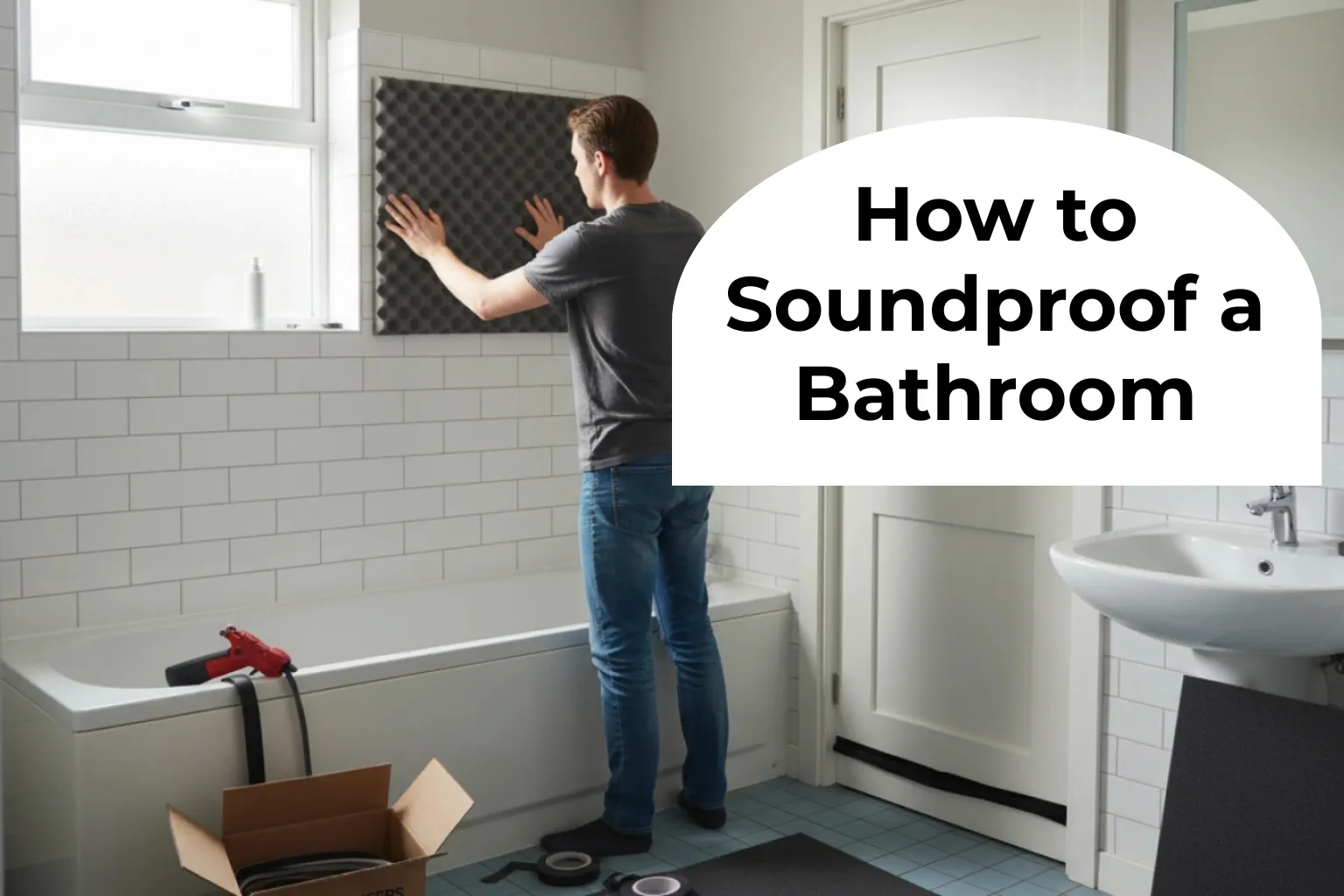This post may contain affiliate links. When you purchase through links on our site, we may earn an affiliate commission. Read our affiliate disclosure
Bathrooms are often noisy places. But it is such a kind of place where you don’t want to sound escape. From flushing toilets and running water to echoing voices, the sounds can easily travel through doors, walls, or vents. When your bathroom is near bedrooms, living rooms, or other shared areas, it may feel nannying. Fortunately, it’s not overly difficult to soundproof a bathroom. With the right methods, you can lower the volume and get more privacy and peace. Here, I have discussed how to soundproof a bathroom.
How to Soundproof a Bathroom? – 8 Simple Ways that Actually Work
1. You Should Begin with the Bathroom Door
Bathroom doors are usually hollow core, and sound penetrates through them. That’s one of the biggest pitfalls with soundproofing. Here’s what you can do:
- Solid wood or solid-core composite doors take sound blocking to the next level.
- This little thing fills the gap at the bottom of the door in a way that no sound can come through.
- Seal the sides and top of the door frame with a rubber weatherstrip (like this one). It seals out air and sound.
- These are complete sealing kits to keep out noise.
Small additions to your bathroom door can do a lot to reduce noise.
2. Use Soft Materials Inside the Bathroom
Bathrooms are full of hard surfaces: tile, mirror, glass. These reflect sound and make echoes. Soft materials in the room help absorb and dampen the sound.
- Hang heavy curtains (my favorite product) or fabric blinds: These can help absorb sound, especially near windows.
- Opt for soft towels and bath mats: Hanging up plush towels (my #1 choice) and rugs like this helps to soften surfaces and dampen sound.
- Use fabric elements: Think about fabric wall coverings and soft furnishings for more sound absorption.
Note: (While these don’t block sound from escaping your bathroom, they can absorb some echo and make it feel quieter.)
3. Focus on the Ceiling and Floor
Sound isn’t only carried through walls and closed doors. Floors and ceilings are also highly effective at letting noise through. So you need to stop the leak. Here are some tips you can follow
Soundproofing the Floor:
- A soft surface absorbs footsteps and muffles sound.
- If you are redoing your floor, place a soundproof mat or foam like this under tiles or vinyl.
- These materials naturally absorb sound and reduce noise impact.
Soundproofing the Ceiling:
If there’s an attic overhead, you can fill between the beams with soundproof insulation. You can find special tiles for the ceiling (you can try this one) that absorb sound and minimize echoes. Just as with walls, a second layer of drywall can help stifle sound from upstairs.
These upgrades are especially helpful in apartment buildings or multi-floor homes.
4. Soundproof the Walls
Thin or uninsulated walls carry sound easily. To stop this, you can either block the sound from entering or absorb it inside the wall.
Easy Wall Soundproofing Methods:
- Add mass-loaded vinyl (MLV): MLV is a flexible sound barrier. You can install it behind drywall. It blocks airborne noise. I recommend this MLV product.
- Install soundproof drywall: You can also install drywall, as it has special layers that resist sound transmission. You can see my recommended Drywall Repair Kit
If you don’t want to install drywall, add a second layer using a damping compound like Green Glue between the two layers. This reduces sound vibration.
You can also use acoustic panels. These panels absorb sound waves. They are great if you want a simple surface solution and don’t want to rebuild walls.
5. Seal All Gaps and Cracks
If there are small holes, it can leak noise. Sound travels through air, so blocking air paths blocks it, too.
- First, you have to inspect corners and joints. You can use acoustic caulk (I highly recommend this) to seal any gaps.
- Check around pipes and fixtures. It can create sound pathways. Seal these gaps with foam sealant or acoustic putty.
- Do you know that even wall sockets and switches can leak sound? Use foam gaskets behind the plates to stop noise from slipping through.
Note: You can learn how to seal gaps in your home using silicone at Quality Seal Australia (QSA)
6. Quiet the Bathroom Fan
Bathroom fans frequently produce noise that extends well beyond the walls of the bathroom. You can eliminate this in two ways:
Choose a hushed fan: Opt for fans rated with low Sones (a unit of sound measurement). A fan that has a rating of less than 1.5 sones is relatively quiet.
Insulate around: Wrap the insulation around the duct. This cuts down on vibration and keeps noise from traveling through ducts.
This can make a world of difference if you’re soundproofing a bathroom next to a quiet room.
7. Set up White Noise Machine (If you have one)
Sometimes, complete soundproofing is not feasible. You can also buy a white noise machine to put in a room outside the bathroom, or a nearby bedroom, to help muffle the noise. It is an easy way to forgo construction to maintain your privacy.
You can also try fans or some soft background music for the same effect.
8. Don’t Forget the Ventilation Ducts
Sound can travel through ductwork, too. If your bathroom has shared ventilation with another room, sound may escape this way.
What to Do:
- You can install duct silencers. These are foam-lined tubes that go inside the duct and reduce sound transmission.
- Line the ducts with acoustic insulation. This step absorbs sound and prevents it from moving through the pipes.
You should go for proper ventilation and soundproofing, which are key for shared systems in homes or buildings.
Final Thoughts
We all can understand that bathroom noise can feel awkward or annoying. There can be a number of sources to create noise. It includes a flushing toilet, running shower, or fan. Soundproofing helps you enjoy a more private, peaceful space.
You don’t need to use every method listed in the article. Pick the options that suit your space, budget, and goals. Even a few simple upgrades can greatly reduce sound and improve bathroom privacy. Choose according to your needs. It will help you get better results without breaking your bank.
Read also:
How to Deep Clean Your Bathroom: 10 Must-Try Tricks That Actually Work
10 Instant Ways to Remove Cigarette Smell from Your Bathroom
10 Ways to Keep Your Bathroom/Toilet Smelling Fresh All the Time

My name is Mostarefa. I am an expert in home improvement. With 10 years of experience in the world of home improvement, I have started this blog to empower readers to make confident design choices and cultivate beautiful, functional living spaces. In this blog, I talk about trending home improvement ideas, as well as cleaning and organizing tips.

